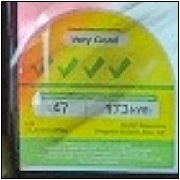|
DammitJanet posted:This machine is just for 1080p gaming. Adding an SSD and a 970 around Xmas. If I'm in danger of a bottleneck, I'd like to overclock my cpu to ~3.6 Ghz, but my case won't fit a Hyper 212. Will a Vortex Plus suffice? If so, will it fit with my stupid RAM? The vortex plus won't cool as well as a bigger cooler but it might fit... Here's how the designers planned it to fit, overhanging the ram:  clearly that won't work with stupid big heatsinks on the corsair vengeance. This guy mounted it so the overhang is facing the top of the board:  This guy mounted it so the overhang is facing the port plate:  Whether either of those configurations will work will depend on your case and motherboard. Either way it's not a fantastic cooler but if a better one won't fit your case you may as well try it out or go for a closed loop cooler, which would also have to fit a radiator in the case somewhere but would take less space around the cpu socket.
|
|
|
|

|
| # ? May 9, 2024 08:39 |
|
Sh4 posted:I upgraded my FX 4350 with an FX9590 but this is still terrible Well, yeah, that was silly..
|
|
|
|
Apparently Corsair measured the clearance a bit wrong, because if you Google the combination of a Spec 03 with a Hyper 212, you get people saying "Yeah, it said it wouldn't fit, but it totally fits." It might be a Corsair push towards their in-house liquid coolers. If you can tolerate a rebate and more noise than a 212 EVO, Cooler Master's Seidon 120V closed-loop liquid cooler is on Newegg for $50 - $20 rebate = $30. Or, keep an eye out for the Phanteks PH-TC12LS that was announced last week - at $40, it'll probably be the new price/performance king for low-profile coolers.
|
|
|
|
Factory Factory posted:Apparently Corsair measured the clearance a bit wrong, because if you Google the combination of a Spec 03 with a Hyper 212, you get people saying "Yeah, it said it wouldn't fit, but it totally fits." It might be a Corsair push towards their in-house liquid coolers. Awesome. The Seidon is sold out at newegg, but I'll keep my eyes peeled for reviews of the Phanteks when it comes out. Thanks!
|
|
|
|
I think I'm just going to give up on OCing my 4790K / Maximus VII GENE with adaptive voltage. 4.5GHz all cores @ manual 1.22Vcore is perfectly stable, but if I switch to adaptive, which is only supposed to affect voltages at turbo frequencies and fiddle with the offset so that it's at the same Vcore under load, I get random W8.1 WHEA_UNCORRECTABLE_ERROR BSODs. It runs cool enough even with constant Vcore, so whatever I guess.
|
|
|
|
GokieKS posted:I think I'm just going to give up on OCing my 4790K / Maximus VII GENE with adaptive voltage. 4.5GHz all cores @ manual 1.22Vcore is perfectly stable, but if I switch to adaptive, which is only supposed to affect voltages at turbo frequencies and fiddle with the offset so that it's at the same Vcore under load, I get random W8.1 WHEA_UNCORRECTABLE_ERROR BSODs. It runs cool enough even with constant Vcore, so whatever I guess. Are you using the AISuite to OC yours or BIOS? I'm able to get mine to maximum 20 runs of IBT @ 4.5 Mhz and 1.22V. Going to do a 12hr run of large FFT Prime95 eventually though. Khagan fucked around with this message at 19:14 on Dec 4, 2014 |
|
|
|
Khagan posted:Are you using the AISuite to OC yours or BIOS? BIOS.
|
|
|
|
I've never overclocked anything but heard that chicks dig guys who do, so could you please take a peek at the following and let me know if I screwed anything up? I don't want to kill my PC - frankly the CPU (i7-2600K @ 3.4GHz) worked just fine most of the time without any tinkering. Thanks. 
Unexpected fucked around with this message at 01:22 on Dec 5, 2014 |
|
|
|
Is the 760GTX worth overclocking? It runs pretty much everything I need it to but I figured if it's as easy as the CPU I might as well squeeze some more juice out of it.
|
|
|
|
Unexpected posted:I've never overclocked anything but heard that chicks dig guys who do, so could you please take a peek at the following and let me know if I screwed anything up? I don't want to kill my PC - frankly the CPU (i7-2600K @ 3.4GHz) worked just fine most of the time without any tinkering. Voltage is higher than the thread recommendation. Drop it to 1.38V and see if it can run a Max Intel Burn Test for 5-20 runs, preferably 20. If not keep reducing the ration until it completes the test.
|
|
|
|
Eh, it's a 2011 processor first overclocked in 2014. By the time it dies from 1.4V instead of 1.38V, we'll be on whatever comes after Cannonlake. Does the processor properly idle with SpeedStep when you used fixed voltage? Like, it should drop to 1-1.1V and 1600 MHz when it's not doing much of anything. If it doesn't, consider redoing the overclock but with an Offset voltage. Start at +0.0 at stock clocks, see what the Vcore is when burning, and then add Offset to get it back to whatever 1.40 manual gives you. Nemesis Of Moles posted:Is the 760GTX worth overclocking? It runs pretty much everything I need it to but I figured if it's as easy as the CPU I might as well squeeze some more juice out of it. All GPUs are worth overclocking, and they're even easier than CPUs. First, max out the power target. Then set the temperature target to something you can tolerate - 80 C is good, or if you are confident in your cooling, 90 C (on the assumption it will never get there). Then set the boost logic to be temperature-dependent. That alone should provide a good boost. But if it's not enough for you, you can then adjust the base frequency upwards. Stress test with Unigine Heaven. If any games you play crash (check at least one of each for DirectX 9, 10, and 11), then dial back the clock offset in 13 MHz increments. If you feel salty you can overvolt it. I've never felt particularly salty - occasionally the gains are good (like when I put my Radeon 6850 to the 6870's stock voltage), but more often modern cards exhaust most of their voltage scaling just with the boost logic. Factory Factory fucked around with this message at 08:16 on Dec 5, 2014 |
|
|
|
Factory Factory posted:Eh, it's a 2011 processor first overclocked in 2014. By the time it dies from 1.4V instead of 1.38V, we'll be on whatever comes after Cannonlake. Ok, awesome, what software should I be using to do this? I'm trying the MSI Afterburner tool but I can't see anything labeled temp target or boost logic anywhere.
|
|
|
|
Okay, I'm a little confused. I've got a msi z97 pc mate, with a g3258. Fully updated BIOS as far as I can tell. The command center (in windows) lets me set CPU ratio and vcore, but the settings don't seem to stick on reboot. The BIOS (which is click BIOS 4) doesn't seem to let me change anything, I can't click on the CPU ratios or the voltages. What am I doing wrong here?
|
|
|
|
Amara posted:Okay, I'm a little confused. I've got a msi z97 pc mate, with a g3258. Fully updated BIOS as far as I can tell. The command center (in windows) lets me set CPU ratio and vcore, but the settings don't seem to stick on reboot. According to the manual when you get into the OC settings panel you turn on advanced mode to have a bunch of options to change settings. It's around page 3-17 in the manual from their support site: http://dl.msi.com/download_files/mnu_exe/E7850v1.1.zip
|
|
|
|
I tried turning on advanced mode as well. It still didn't allow any of the cores or voltages to be clicked. Even the simple mode ought to have allowed basic overclocking. I may go track down some video tutorials and see how they go about it. Edit: nevermind, figured it out. You don't click on those settings to change them, you just start typing when they're highlighted. I wish this were anywhere in their manual or instructions. Guess it's a carryover from more standard bioses and they just assumed everyone already knew? Amara fucked around with this message at 08:30 on Dec 7, 2014 |
|
|
|
I just picked up a G3258 for a secondary machine, but I'm hitting a hard wall at 3.7ghz. Tried vCore at 1.2v, and 3.8 just instantly crashes. It can't be thermals, it doesn't have any time to heat up - I hit "go" and it blackscreens/bluescreens/corrupts the video/trips reset. FWIW, I'm doing this in the asrock "a-tuning" software, not in the bios - and it allows separate tweaking of cache and core multipliers. What voltage/multiplier combos are people running?
|
|
|
|
Ok, turns out adaptive would up my vcore higher than i would set it. So ive had it manually set to 1.205v stable with much better temps (mid 70s to low 80s) and gflops (~207) in LinX to boot.
|
|
|
|
Harik posted:I just picked up a G3258 for a secondary machine, but I'm hitting a hard wall at 3.7ghz. At that voltage I'm pretty sure you should be able to get 3.8 no problem. I'm running 4 on much less. I'd suggest trying it in BIOS, is there any reason you're not doing that?
|
|
|
|
I'm trying to troubleshoot my overclock. I've got a G3258 at 4.7 (vcore on adaptive set to 1.3 since it was stable there on testing) gskills ripjaws 8gb ram, rated at 1600 and clocked at 2133 Radeon R9 280 at 1145 clock and 1575 memory I thought these were all stable, tested with prime95, the pi calculator, and heaven. Then yesterday I tried to run Mass Effect 2 and after a pretty random amount of time this happens:  It's not the standard crash I'm used to where the computer restarts or BSOD happens. The lines on the screen flicker a bit but you can't do anything. And everything is fine after restart. Looked at the temperatures with HWiNFO64, nothing is running hotter than 70 max. I was hoping this type of screen indicates to someone more knowledgeable than I am what sort of error is occurring. Like, which of my CPU, ram, GPU clock, or GPU memory should I be fiddling with first?
|
|
|
|
GPU core overclock set too high probably, or at least insufficient voltage. What power supply are you using? edit: Factory Factory makes a good point. If your 280 has Elpida VRAM it's likely to be overclocked too far, and it might not be truly stable at those clocks even with Hynix chips, assuming 280's are even made with those. future ghost fucked around with this message at 23:11 on Dec 13, 2014 |
|
|
|
Both of those RAM overclocks seem pretty high. Not all R9-280s have 6 GHz RAM chips, and does the system memory really pass at least two passes of memtest86+ like that?
|
|
|
|
cisco privilege posted:GPU core overclock set too high probably, or at least insufficient voltage. What power supply are you using? I haven't messed with gpu voltage. The power supply is a rosewill capstone gold 650W. I don't know what the rest of that means, except that I should crank the gpu memory down? Factory Factory posted:Both of those RAM overclocks seem pretty high. Not all R9-280s have 6 GHz RAM chips, and does the system memory really pass at least two passes of memtest86+ like that? I'm going to run memtest86+ overnight to see how it does.
|
|
|
|
CPU: i5-3570K MB: Asus P8Z77-M CPU Cooler: CM Hyper 212 EVO I've had the machine a little over 2 years at this point. Maybe a year ago, I read over part of the OP and bumped up the turbo ratio to 42 and pretty much left everything else alone (including voltage). I think I ran Prime for a while and nothing blew up so I've been using it without any noticeable issues since then. I've spent today actually reading over the OP and tweaking settings on my machine trying to do a more educated and thorough OC. I started the day by bumping the turbo ratio up to 43 (and left voltage at stock), but I immediately noticed after running IBT, that my temps were several degrees past 80C already. Eventually I just reset everything in my BIOS and started over. After bumping the clocks up a while, I experimented and found I could actually lower the voltage and remain stable while lowering temps a bit overall. Around 43, it gets unstable, and by the time I up the voltage enough, I'm hitting 83C in IBT. So at this point, I'm sitting about -0.30V offset from stock at 42. I can maintain 80C in IBT, so I swapped over to Prime95 (MaxFFT), and after about 5 minutes, HWInfo looked like this: http://imgur.com/QhJTooK Temps were sitting around 76C, but my understanding is the upper limit per core while running Prime is 72C. From what I've read in this thread, the consensus has been my setup should be able to get closer to 45 before hitting the temp wall. Am I reading the numbers right? Did I just get a particularly bad chip, or perhaps I just mounted the cooler poorly? (Also I realize I stated that I had it at 42 before I started this today, but after seeing the temps I was hitting when running tests with 42 at close to stock voltages, it concerned me.) jkyuusai fucked around with this message at 03:49 on Dec 15, 2014 |
|
|
|
Temperature walls are more related to voltage than clock speeds (though clock speeds are also related to voltage). And voltage (well, Vcore) looks sufficiently low. I'm tempted to say that the cooler might not have been installed correctly - maybe you pre-spread the thermal paste and there are air bubbles trapped? Best way to improve temperatures would just be to delid the thing and clean up the IHS adhesive.
|
|
|
|
jkyuusai posted:CPU: i5-3570K Considering the chip and voltage it seems a *tad* higher than usual and I'd agree with Factory about reseating at least. However, 76 degrees is in no way bad for stress testing. I don't know about a 72 degree limit for P95 other than absolute safety and longevity. The evo is not an overclocking champ though. Unless some new info has come out I don't mind anywhere in the 70's for P95 and pretty much anywhere in the 80's for small FFT or IBT. I have never even once seen any real load push into IBT zone, although video encoding will get close. Which brings me to why I'm here. I've been stable for months and months at 4.5 ghz and 1.35 vcore (4670k). That's actually my lazy multiplier, I know its stable at 4.6 and ~1.40 or 1.385 (I know, not great). This is with IBT, smallFFT for many hours, and regular use for at least half a year. I never blue screen. Until I used Handbrake yesterday. No amount of voltage could keep it from blue screening, either vrin, vcore, cache voltage. I had to drop to a 44 multiplier and bump the voltage to 4.6 ghz levels. I'm not going to keep it that way simply because I never really encode anything but I was very surprised it was able to crash me so reliably when nothing else would. I guess I'm not even asking for help really (unless there is something I missed here), but I guess I'll be using Handbrake to finish off any stress testing in the future.
|
|
|
|
Thanks for the feedback, both of you. I was basing those temp limits off some posts I saw in this thread, so I'm definitely not married to them or anything. I guess I should also consider that I've been running the thing at this level for a year with no obvious ill effects (though I guess we could really stretch the smoking metaphor and say there could always be trouble around the corner/potentially greatly reduced life expectancy/etc.) And as you say, those temps are likely never getting hit in daily use anyway. On the other hand, delidding looks neat, and if I'm going to have to reseat it anyway.....wonder if any of my friends have a vise laying around. 
|
|
|
|
jkyuusai posted:Thanks for the feedback, both of you. I was basing those temp limits off some posts I saw in this thread, so I'm definitely not married to them or anything. If I had to guess you'd be low 60's under 100% load for an intense online game of some kind. I wouldn't worry much. If you don't have a vise the razor blade method works just fine, just go slowly and don't push it in too far - think a few mm around the edge. For the cost of some good (non conductive!) TIM its the best thing you can do for the dollar.
|
|
|
|
1gnoirents posted:Which brings me to why I'm here. I've been stable for months and months at 4.5 ghz and 1.35 vcore (4670k). That's actually my lazy multiplier, I know its stable at 4.6 and ~1.40 or 1.385 (I know, not great). This is with IBT, smallFFT for many hours, and regular use for at least half a year. I never blue screen. Video encoding is practically as tough on a CPU as a stress test. Video encoding uses a bit of everything on a CPU, but is especially heavy on floating point, including AVX instructions. It's also very reliant on memory bandwidth and highly parallelizable, so as much of each core as possible is going to be lighting up from out-of-order execution running a whole bunch of stuff in parallel on each core, even without hyperthreading. Temperature-wise, it can match Prime95 or even IntelBurnTest. So if any common real-world workload would bring an overclock to its knees, it'd be video encoding. But that said, that's not the first time I've seen a pattern like that and I'm wondering if I shouldn't mention it in the OP. Agreed aggressively volted his CPU (1.38V), and now it can't hold its old clock. My own CPU, despite having an excellent voltage response (i5-2500K 4.6 GHz @ 1.28V), had a low upper limit, and now it's even lower - 4.4 GHz at the same voltage. Electromigration isn't purely a "suddenly it stops" phenomenon; physically, it's progressive degredation. High volts will knock poo poo around.  I don't know, but it seems plausible that this could be the physical erosion of linkages to the point where the chip can't handle such an aggressive switching speed cleanly. The bottleneck was already the weakest link, after all.
|
|
|
|
Thanks for the information man. I wouldn't be particularly surprised if I degraded it a bit after all I put it through. I wish I had tested it at the start though.
|
|
|
|
Using MSI Afterburner for my GTX970, I set the power limit to max on the slider, temperature limit to 80C, core voltage offset to +37mV (max it will go), and played around with different core clock settings. No matter what, I hit the volt limit and OV max limit right away and the core clock never exceeds 1304MHz. Power and thermal limits are well under the settings (87% and 40-50C, respectively). Am I missing something? I don't see any settings to play with in my BIOS so I assume it's not a limitation of the mobo (Asrock Z97 Pro4). For CPU overclocking, my BIOS has a Vcore Adaptive Voltage setting which is described as "voltage added to CPU when system is under heavy load" and a Vcore Voltage Additional Offset setting described as "dynamic CPU voltage added to the CPU". I assume the latter is the offset and I should leave the former on Auto, but during stress tests my Vcore never gets above ~1.20V. I'm stable at 45x (if-4690K) with the above settings on Auto and +0.0 respectively, but increasing the multiplier at all from there causes BSOD on startup. Separate question, do I need to do anything with the CPU Cache multiplier and voltage settings? I can post BIOS screenshots if needed to see what's available.
|
|
|
|
Papercut posted:Using MSI Afterburner for my GTX970, I set the power limit to max on the slider, temperature limit to 80C, core voltage offset to +37mV (max it will go), and played around with different core clock settings. No matter what, I hit the volt limit and OV max limit right away and the core clock never exceeds 1304MHz. Power and thermal limits are well under the settings (87% and 40-50C, respectively). Am I missing something? I don't see any settings to play with in my BIOS so I assume it's not a limitation of the mobo (Asrock Z97 Pro4). I'm confused about the afterburner stuff. Does it crash after 1304 mhz? What happens if you just add more? Are you adding any clock offset at all or is 1304 just what its boosting to with its raised voltage limits? For CPU stuff, I hate adaptive vcore. I might be outdated or wrong, but I highly prefer to have manual vcore. This does not mean it will always be running at that voltage, its just means it will go as high as what you set it to. I'd encourage you to do this here in particular because if you're really stable at 4.5 with 1.20 vcore you might have quite a bit on the table. So for instance, set it to 1.25 and raise the multiplier (although add voltage after 1.25 slowly at 0.01 at a time generally) Cache multiplier and voltage can help or destabilize. When you are OC'ing on Haswell, go ahead and set your cache multiplier low (say, 36) and turbo boost off if you haven't already. Once you run out of stability raising vcore, you can raise cache voltage to attempt to increase stability. The third voltage to raise is vrin or overall voltage. I actually tend to set this at 1.950 to start to alleviate that possible bottleneck if temps aren't an issue... lazy, I know, but I lower it later when its all stable and good. Once you are at your stable cpu multiplier, go ahead and do the same thing with your cache multiplier without touching any other voltages. You may not get very far, or you may get very close to 1:1. It depends where you are getting destabilized. Cache multiplier is not very important relative to cpu multiplier so don't worry too much if can't get very high (if the trade off means stability)
|
|
|
|
1gnoirents posted:I'm confused about the afterburner stuff. Does it crash after 1304 mhz? What happens if you just add more? Are you adding any clock offset at all or is 1304 just what its boosting to with its raised voltage limits? Thanks for the tips! On the GPU, disregard. I was certain that I had checked and double-checked that I was setting the core clock offset, but I had been setting the memory clock offset. Working as expected now.
|
|
|
|
Figured this is a bit anal to be posting in the parts picking thread: I'm working on an ITX build that currently uses a G3258, and I'll get a Broadwell-K down the line which is expected to be around 65w TDP. Now, I slapped on a Corsair H90 I had lying around, and it turns out that overclocked to 4.4ghz, HWMonitor is reporting the CPU package is only drawing 50 watts max. As a result, The CPU isn't going above 53c on Prime95 even without a fan! Just the water circulating in the CLC is passively cooling the CPU and the radiator is cool to the touch at max load for hours. At idle it only draws 15 watts and I can even unplug the pump and still have it stay below 50c (though Prime95 will heat it to throttling). The pump is actually the loudest thing in this system and it's a much more annoying rattle than the white noise of the fans, so do you think there's any kind of passive cooler I can buy that will keep things below 80c at load? I want something that is still low-profile because I'm building a small case. The case is completely perforated on all sides so heat can radiate out on its own. I'm looking at: http://www.newegg.com/Product/Product.aspx?Item=9SIA66Z28G9560&cm_re=pallas-_-9SIA66Z28G9560-_-Product http://www.ebay.com/itm/Scythe-Kozuti-SCKZT-1000-CPU-Cooler-Heatsink-Low-Profile-Design-for-AMD-or-Intel-/221640945834 http://www.newegg.com/Product/Product.aspx?Item=N82E16835709017 Any guess as to which of those would be most appropriate at 50-75w of heat? Or is there anything else I'm missing?
|
|
|
|
Zero VGS posted:Figured this is a bit anal to be posting in the parts picking thread: None of those heatsinks are passive, they all have fans that you'll need to use. There aren't any passive heatsinks that will fit in a sff case. Try switching out the clc w/ the heat sink that came with the chip. That's a free change you can make to see if the noise level is any better. If the stock HS is still too loud then you can look into an after market cooler like the first two you linked. Don't get the phanteks that you linked, it's no better than the stock cooler, they make one similar in design to the other ones that you could use instead.
|
|
|
|
I'll be keeping my PC under a desk, how far from the back/wall does it need to be for the exhaust to do it's thing? I assume air would just dissipate upwards once it hits the wall anyway right? Alternatively there would be plenty of open space on the top so I could fit another exhaust there as the case has an unused vent slot, would that be a good idea or just mess up the air flow? Current setup below, it got one of these at both the front and back at the moment.
|
|
|
|
Avalerion posted:I'll be keeping my PC under a desk, how far from the back/wall does it need to be for the exhaust to do it's thing? I assume air would just dissipate upwards once it hits the wall anyway right? Alternatively there would be plenty of open space on the top so I could fit another exhaust there as the case has an unused vent slot, would that be a good idea or just mess up the air flow? Current setup below, it got one of these at both the front and back at the moment. Realistically worry more about crimping cords plugged into the back than obstructing airflow. The only ones to worry about are side vents, because the case is flat enough you could block them off.
|
|
|
|
Rexxed posted:Yeah it's good for overclocking. Depending on your uses the i5-4690K might be a better choice; it depends if you have use for hyperthreading with tasks that are highly multithreaded like video rendering, 3d modelling and the like. For gaming the quad core i5 is the best value for money since most games only have 1-3 threads. X99 isn't worthwhile for most people. If you ask me, OCing as a value for money activity is dead for Haswell. http://techreport.com/forums/viewtopic.php?f=2&t=64370&start=60
|
|
|
|
I just put together a value engineered rig using a G3258 and an MSI Z87-G41 w/ stock cooling. I don't think I've overclocked since Conroe so I'm a bit rusty and things have really changed in eight years. I read through the OP's, but it seems like MB makers use different terms so I'm a little lost. I started off by just bumping the multiplier up to 40 (stock is 32) and ran Prime95 for a while. I didn't touch voltage settings at all. Everything ran great on Prime95 for 24 hours with temps maxing out at the low 60C's. I've bumped it up all the way to 43x and am currently at 12+ hours on Prime95 with no problems. I feel like I'm missing something here? Should I be happily getting 4.3ghz without touching voltage? I was only shooting for 4.3-4.4ghz anyway given my stock cooling setup, so if I don't have to tune voltages I'll be thrilled. The box lives in an office that is not typically heated unless I'm out there so the room temperature is probably under 50F at the moment and will obviously fluctuate throughout the year. Nothing too crazy, I would suspect high ambient temps to stay below 90F in the worst of summer with little humidity. I've posted the screenshots of my HWiNFO64 monitor on the latest 4.3ghz OC as well as some earlier shots of my BIOS just so you know what parameters I have to work with. It seems like I'm missing the TDP settings, but I haven't played around with it much.      BeastOfExmoor fucked around with this message at 17:53 on Dec 30, 2014 |
|
|
|
Are you happy with that? Do you want more out of life? Are you living on the edge and want to push the envelope to the extreme maximum?
|
|
|
|

|
| # ? May 9, 2024 08:39 |
|
Every 100 mhz is worth it out of that chip, but 4.3 is getting to the happy side of things. Its auto volting so thats why you haven't touched the voltage. Auto volting can be stable, unstable, extremely wasteful, or pretty good. That's why its generally better to manually do it, but its gotten way better than it used to be. Nothing wrong with 1.28 v at 4.3 ghz if its truly stable so if it works, it works. Personally I would try 1.30 (this is a good moderate voltage) and see how high I could get but you certainly dont need to now. But just to be clear the motherboard is touching the voltage in just the same way that you would be, thats definitely getting into firmly overclocking voltages. There could have been serious pitfalls with that chip at every turn but everything works out so well. I am always impressed by the temperatures per voltage.
|
|
|
























